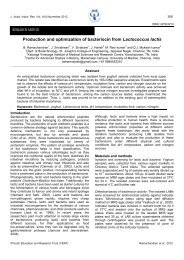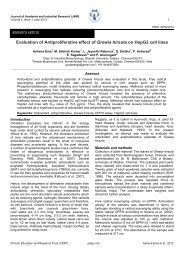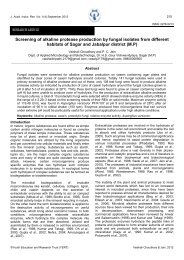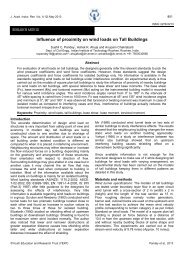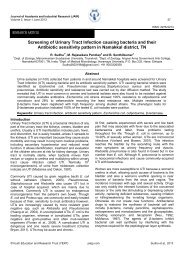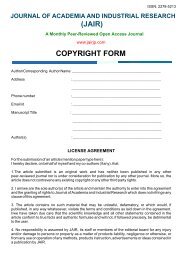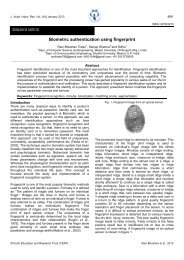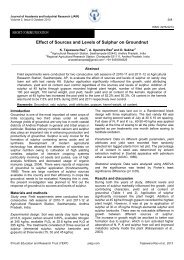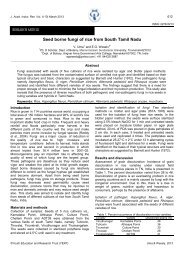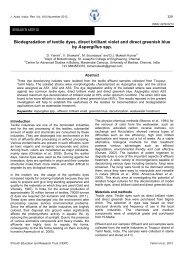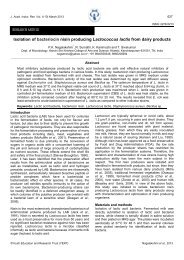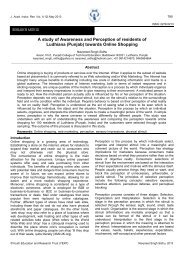Use of glass wastes as fine aggregate in Concrete
Use of glass wastes as fine aggregate in Concrete
Use of glass wastes as fine aggregate in Concrete
Create successful ePaper yourself
Turn your PDF publications into a flip-book with our unique Google optimized e-Paper software.
J. Acad. Indus. Res. Vol. 1(6) November 2012 320SHORT COMMUNICATIONISSN: 2278-5213<strong>Use</strong> <strong>of</strong> <strong>gl<strong>as</strong>s</strong> <strong>w<strong>as</strong>tes</strong> <strong>as</strong> <strong>f<strong>in</strong>e</strong> <strong>aggregate</strong> <strong>in</strong> <strong>Concrete</strong>S.P. Gautam, Vik<strong>as</strong> Sriv<strong>as</strong>tava and V.C. AgarwalCivil Engg. Dept., SHIATS (formerly AAI-DU), Allahabad-211007, UP, Indiagautam.civil2009@gmail.com; +91 9415369170______________________________________________________________________________________________AbstractGl<strong>as</strong>s is widely used <strong>in</strong> our lives through manufactured products such <strong>as</strong> sheet <strong>gl<strong>as</strong>s</strong>, bottles, <strong>gl<strong>as</strong>s</strong>ware, andvacuum tub<strong>in</strong>g. Gl<strong>as</strong>s is an ideal material for recycl<strong>in</strong>g. The use <strong>of</strong> recycled <strong>gl<strong>as</strong>s</strong> helps <strong>in</strong> energy sav<strong>in</strong>g.The <strong>in</strong>cre<strong>as</strong><strong>in</strong>g awareness <strong>of</strong> <strong>gl<strong>as</strong>s</strong> recycl<strong>in</strong>g speeds up <strong>in</strong>spections on the use <strong>of</strong> w<strong>as</strong>te <strong>gl<strong>as</strong>s</strong> with differentforms <strong>in</strong> various fields. One <strong>of</strong> its significant contributions is to the construction field where the w<strong>as</strong>te <strong>gl<strong>as</strong>s</strong>w<strong>as</strong> reused for concrete production. The application <strong>of</strong> <strong>gl<strong>as</strong>s</strong> <strong>in</strong> architectural concrete still needsimprovement. Laboratory experiments were conducted to further explore the use <strong>of</strong> w<strong>as</strong>te <strong>gl<strong>as</strong>s</strong> <strong>as</strong> coarseand <strong>f<strong>in</strong>e</strong> <strong>aggregate</strong>s for both ASR (Alkali-Silica-Reaction) alleviation <strong>as</strong> well <strong>as</strong> the decorative purpose <strong>in</strong>concrete. The study <strong>in</strong>dicated that w<strong>as</strong>te <strong>gl<strong>as</strong>s</strong> can effectively be used <strong>as</strong> <strong>f<strong>in</strong>e</strong> <strong>aggregate</strong> replacement (up to40%) without substantial change <strong>in</strong> strength.Keywords: Gl<strong>as</strong>s, recycl<strong>in</strong>g, concrete, construction field, alkali-silica-reaction, <strong>f<strong>in</strong>e</strong> <strong>aggregate</strong>.IntroductionGl<strong>as</strong>s is a transparent material produced by melt<strong>in</strong>g amixture <strong>of</strong> materials such <strong>as</strong> silica, soda <strong>as</strong>h, and CaCO 3at high temperature followed by cool<strong>in</strong>g wheresolidification occurs without crystallization. Gl<strong>as</strong>s iswidely used <strong>in</strong> our lives through manufactured productssuch <strong>as</strong> sheet <strong>gl<strong>as</strong>s</strong>, bottles, <strong>gl<strong>as</strong>s</strong>ware, and vacuumtub<strong>in</strong>g. Gl<strong>as</strong>s is an ideal material for recycl<strong>in</strong>g. The use<strong>of</strong> recycled <strong>gl<strong>as</strong>s</strong> saves lot <strong>of</strong> energy and the <strong>in</strong>cre<strong>as</strong><strong>in</strong>gawareness <strong>of</strong> <strong>gl<strong>as</strong>s</strong> recycl<strong>in</strong>g speeds up focus on the use<strong>of</strong> w<strong>as</strong>te <strong>gl<strong>as</strong>s</strong> with different forms <strong>in</strong> various fields. One<strong>of</strong> its significant contributions is the construction fieldwhere the w<strong>as</strong>te <strong>gl<strong>as</strong>s</strong> w<strong>as</strong> reused for concreteproduction. The application <strong>of</strong> <strong>gl<strong>as</strong>s</strong> <strong>in</strong> architecturalconcrete still needs improvement. Several study haveshown that w<strong>as</strong>te <strong>gl<strong>as</strong>s</strong> that is crushed and screened is <strong>as</strong>trong, safe and economical alternative to sand used <strong>in</strong>concrete. Dur<strong>in</strong>g the l<strong>as</strong>t decade, it h<strong>as</strong> been recognizedthat sheet <strong>gl<strong>as</strong>s</strong> w<strong>as</strong>te is <strong>of</strong> large volume and is<strong>in</strong>cre<strong>as</strong><strong>in</strong>g year by year <strong>in</strong> the shops, construction are<strong>as</strong>and factories.Us<strong>in</strong>g w<strong>as</strong>te <strong>gl<strong>as</strong>s</strong> <strong>in</strong> the concrete construction sector isadvantageous, <strong>as</strong> the production cost <strong>of</strong> concrete will godown. The amount <strong>of</strong> w<strong>as</strong>te <strong>gl<strong>as</strong>s</strong> is gradually <strong>in</strong>cre<strong>as</strong>edover the years due to an ever-grow<strong>in</strong>g use <strong>of</strong> <strong>gl<strong>as</strong>s</strong>products. Most <strong>of</strong> the w<strong>as</strong>te <strong>gl<strong>as</strong>s</strong>es have been dumped<strong>in</strong>to landfill sites. The land fill<strong>in</strong>g <strong>of</strong> w<strong>as</strong>te <strong>gl<strong>as</strong>s</strong>es isundesirable because they are not biodegradable, whichmakes them environmentally less friendly. There is hugepotential for us<strong>in</strong>g w<strong>as</strong>te <strong>gl<strong>as</strong>s</strong> <strong>in</strong> the concreteconstruction sector. When w<strong>as</strong>te <strong>gl<strong>as</strong>s</strong>es are reused <strong>in</strong>mak<strong>in</strong>g concrete products, the production cost <strong>of</strong>concrete will go down (Topcu and Canbuz, 2004).Crushed <strong>gl<strong>as</strong>s</strong> or cullet, if properly sized and processed,can exhibit characteristics similar to that <strong>of</strong> gravel orsand.When used <strong>in</strong> construction applications, w<strong>as</strong>te <strong>gl<strong>as</strong>s</strong>must be crushed and screened to produce anappropriate design gradation. Gl<strong>as</strong>s crush<strong>in</strong>g equipmentnormally used to produce a cullet is similar to rockcrush<strong>in</strong>g equipment. Because <strong>gl<strong>as</strong>s</strong> crush<strong>in</strong>g equipment<strong>in</strong> <strong>gl<strong>as</strong>s</strong> sector h<strong>as</strong> been primarily designed to reduce thesize or density <strong>of</strong> the cullet for transportation purposesand for use <strong>as</strong> a <strong>gl<strong>as</strong>s</strong> production feedstock material, thecrush<strong>in</strong>g equipment used is typically smaller and usesless energy than conventional <strong>aggregate</strong> or rockcrush<strong>in</strong>g equipment (Egosi, 1992). W<strong>as</strong>te <strong>gl<strong>as</strong>s</strong>es areused <strong>as</strong> <strong>aggregate</strong>s for concrete (Johnson, 1998,M<strong>as</strong>aki, 1995; Park, 2000). However, the applicationsare limited due to the damag<strong>in</strong>g expansion <strong>in</strong> theconcrete caused by ASR between high-alkali pore water<strong>in</strong> cement p<strong>as</strong>te and reactive silica <strong>in</strong> the w<strong>as</strong>te <strong>gl<strong>as</strong>s</strong>es.The chemical reaction between the alkali <strong>in</strong> Portlandcement and the silica <strong>in</strong> <strong>aggregate</strong>s forms silica gel thatnot only causes crack upon expansion, but also weakensthe concrete and shortens its life (Swamy, 2003).Ground w<strong>as</strong>te <strong>gl<strong>as</strong>s</strong> w<strong>as</strong> used <strong>as</strong> <strong>aggregate</strong> for mortarsand no reaction w<strong>as</strong> detected with <strong>f<strong>in</strong>e</strong> particle size, thus<strong>in</strong>dicat<strong>in</strong>g the fe<strong>as</strong>ibility <strong>of</strong> the w<strong>as</strong>te <strong>gl<strong>as</strong>s</strong> reuse <strong>as</strong> <strong>f<strong>in</strong>e</strong><strong>aggregate</strong> <strong>in</strong> mortars and concrete. Estimated cost forhous<strong>in</strong>g is more and some construction materials likenatural sand are also becom<strong>in</strong>g rare. W<strong>as</strong>te <strong>gl<strong>as</strong>s</strong>es areused <strong>as</strong> <strong>aggregate</strong>s for concrete. In this study, anextensive experimental work w<strong>as</strong> carried out to f<strong>in</strong>d thesuitability <strong>of</strong> use <strong>of</strong> w<strong>as</strong>te <strong>gl<strong>as</strong>s</strong> <strong>in</strong> concrete with thefollow<strong>in</strong>g objectives:1. To study the workability <strong>of</strong> concrete mode us<strong>in</strong>g <strong>gl<strong>as</strong>s</strong>w<strong>as</strong>te <strong>as</strong> partial replacement <strong>of</strong> <strong>f<strong>in</strong>e</strong> <strong>aggregate</strong>.2. To study the compressive strength <strong>of</strong> concrete modeus<strong>in</strong>g <strong>gl<strong>as</strong>s</strong> w<strong>as</strong>te <strong>as</strong> partial replacement <strong>of</strong> <strong>f<strong>in</strong>e</strong><strong>aggregate</strong>.©Youth Education and Research Trust (YERT) Gautham et al., 2012
J. Acad. Indus. Res. Vol. 1(6) November 2012 321Materials and methodsIn order to study the effect <strong>of</strong> w<strong>as</strong>te <strong>gl<strong>as</strong>s</strong> <strong>as</strong> partialcement replacement on the strength <strong>of</strong> concrete, <strong>f<strong>in</strong>e</strong><strong>aggregate</strong> and coarse <strong>aggregate</strong>, 66 cubes <strong>of</strong> size100 mm × 100 mm × 100 mm were c<strong>as</strong>t for differentpercentage <strong>of</strong> demolished w<strong>as</strong>te and for 0% w<strong>as</strong>te <strong>gl<strong>as</strong>s</strong>for a mix have been c<strong>as</strong>t <strong>in</strong> the laboratory. An effort h<strong>as</strong>been made here to compare the strength <strong>of</strong> cubes madeup with different percentage <strong>of</strong> demolished w<strong>as</strong>te to therespective strength <strong>of</strong> conventional concrete at the end<strong>of</strong> 7 and 28 d <strong>of</strong> moist cur<strong>in</strong>g and to have an idea aboutthe optimum percentage <strong>of</strong> demolished w<strong>as</strong>te whichdoes not affect the strength <strong>of</strong> recycled concreteconsiderably. Similarly <strong>f<strong>in</strong>e</strong> <strong>aggregate</strong> and coarse<strong>aggregate</strong>s w<strong>as</strong> also partially replaced by demolishedw<strong>as</strong>te and only cubes were c<strong>as</strong>t and tested after 7 and28 d for mix <strong>of</strong> 1:1.67:3.33 at a w/c <strong>of</strong> 0.50.The coarse <strong>aggregate</strong> are granular materials obta<strong>in</strong>edfrom rocks and crushed stones. They can be alsoobta<strong>in</strong>ed from synthetic material like slag, shale, fly <strong>as</strong>hand clay for use <strong>in</strong> light-weight concrete.Table 2. Physical properties <strong>of</strong> cement.Standard consistency Days 31%Initial sett<strong>in</strong>g time - 92 m<strong>in</strong>F<strong>in</strong>al sett<strong>in</strong>g time - 195 m<strong>in</strong>3 27.1 MPACompressive strength 7 38.0 MPA28 80.0 MPAFig. 1. Test set up for compressive strength test <strong>of</strong> concrete.Cement: In this work, Ord<strong>in</strong>ary Portland cement (OPC) <strong>of</strong>Birla (43 grade) brand obta<strong>in</strong>ed from a s<strong>in</strong>gle batchesw<strong>as</strong> used. The physical properties <strong>of</strong> OPC <strong>as</strong> determ<strong>in</strong>edare given <strong>in</strong> Table 1. The cement satisfies therequirement <strong>of</strong> IS: 8112-1989. The specific gravity w<strong>as</strong>2.96 and <strong>f<strong>in</strong>e</strong>ness w<strong>as</strong> 2800 cm 2 /g.Table 1. Typical composition <strong>of</strong> ord<strong>in</strong>ary portland cement.ChemicalWeightTri-calcium silicate -C 3S 55%Di-calcium silicate -C 2S 18%Tri-calcium alum<strong>in</strong>ate -C 3A 10%Tetra-calcium alum<strong>in</strong>o ferrite -C 4AF 8%Calcium sulphate dihydrate -CSH 2 6%F<strong>in</strong>e <strong>aggregate</strong>: F<strong>in</strong>e <strong>aggregate</strong>/sand is an accumulation<strong>of</strong> gra<strong>in</strong>s <strong>of</strong> m<strong>in</strong>eral matter derived from the dis<strong>in</strong>tegration<strong>of</strong> rocks. It is dist<strong>in</strong>guished from gravel only by the size <strong>of</strong>gra<strong>in</strong> or particle, but is dist<strong>in</strong>ct from clays which conta<strong>in</strong>organic m<strong>in</strong>erals. Sands that have been sorted out andseparated from the organic material by the action <strong>of</strong>currents <strong>of</strong> water or by w<strong>in</strong>ds across arid lands aregenerally quite uniform <strong>in</strong> size <strong>of</strong> gra<strong>in</strong>s. Usuallycommercial sand is obta<strong>in</strong>ed from river beds or fromsand dunes orig<strong>in</strong>ally formed by the action <strong>of</strong> w<strong>in</strong>ds.Much <strong>of</strong> the earth’s surface is sandy, and the sand isusually quartz and other siliceous materials. Sand isused to make mortar and concrete and for mak<strong>in</strong>g molds<strong>in</strong> foundries.Coarse <strong>aggregate</strong>: Coarse <strong>aggregate</strong> are the crushedstone used for mak<strong>in</strong>g concrete. The commercial stone isquarried, crushed and graded. Much <strong>of</strong> the crushedstone used is granite, limestone and trap rock. Crushedangular granite metal <strong>of</strong> 10 mm size from a local sourcew<strong>as</strong> used <strong>as</strong> coarse <strong>aggregate</strong>. The specific gravity <strong>of</strong>2.6 and <strong>f<strong>in</strong>e</strong>ness modulus 6.05 w<strong>as</strong> used.Water: Potable water is used for mix<strong>in</strong>g and cur<strong>in</strong>g. Onaddition <strong>of</strong> higher percentage <strong>of</strong> demolished w<strong>as</strong>te therequirement <strong>of</strong> water <strong>in</strong>cre<strong>as</strong>es for the same workability.Thus, a constant slump h<strong>as</strong> been the criteria for waterrequirement but the specimens hav<strong>in</strong>g 0% demolishedw<strong>as</strong>te, w/c <strong>of</strong> 0.50 h<strong>as</strong> been used.<strong>Concrete</strong>: The concrete mix design is done <strong>in</strong>accordance with IS: 10262 (1982). The cement content<strong>in</strong> the mix design is taken <strong>as</strong> 380 kg/m 3 which satisfiesm<strong>in</strong>imum requirement <strong>of</strong> 300 kg/m 3 <strong>in</strong> order to avoid theball<strong>in</strong>g effect. Good stone <strong>aggregate</strong> and natural riversand <strong>of</strong> zone-∥ w<strong>as</strong> used <strong>as</strong> coarse <strong>aggregate</strong> and <strong>f<strong>in</strong>e</strong><strong>aggregate</strong> respectively. Maximum size <strong>of</strong> coarse<strong>aggregate</strong> w<strong>as</strong> 12.5 mm. A sieve analysis conform<strong>in</strong>g toIS: 383-1970 w<strong>as</strong> carried out for both the <strong>f<strong>in</strong>e</strong> and coarse<strong>aggregate</strong> .<strong>Concrete</strong> may be produced <strong>as</strong> a dense m<strong>as</strong>swhich is practically artificial rock and chemicals may beadded to make it waterpro<strong>of</strong> or it can be made porousand highly permeable for such use <strong>as</strong> filter beds.Table 3. Sieve analysis <strong>of</strong> <strong>aggregate</strong>s.Material sieve sizePercentage p<strong>as</strong>s<strong>in</strong>g40 20 10.5 10 4.75 2.36 1.18 0.6 0.3 0.1520 mm 100 90.8 11.2 0.0 0.0 - - - - -12.5 mm - - 98.8 83.8 - 1.4 0.0 - - -Sand - - - 100 100 93.2 65.2 38.9 12.5 0.8©Youth Education and Research Trust (YERT) Gautham et al., 2012
J. Acad. Indus. Res. Vol. 1(6) November 2012 322Table 4. Properties <strong>of</strong> <strong>aggregate</strong>s.Property Sand Coarse <strong>aggregate</strong>20 mm 12.5 mmSpecific gravity 2.62 2.71 2.70Bulk density (kg/m 3 ) 1573 1477 1489Table 5. Compressive strength.Compressive strengthCube(N/mm 2 )designationGl<strong>as</strong>s (%)7 days 28 daysI 14.66 30.33 0II 21.66 31.33 10III 16.66 31.00 20IV 16.33 29.66 30V 16.33 29.33 40VI 20.33 24.33 50Fig. 2. Variation <strong>in</strong> compressive strength <strong>of</strong> <strong>gl<strong>as</strong>s</strong> w<strong>as</strong>te concrete.Compressive Strength (MPa)3530252015105030.3314.6631.33 3121.6629.66 29.3316.66 16.33 16.337 Days28 Days24.3320.330 20 40 60W<strong>as</strong>te <strong>gl<strong>as</strong>s</strong> content (%)An air-entra<strong>in</strong><strong>in</strong>g chemical may be added to producem<strong>in</strong>ute bubbles for porosity. Normally, the full harden<strong>in</strong>gperiod <strong>of</strong> concrete is at le<strong>as</strong>t 7 d. The gradual <strong>in</strong>cre<strong>as</strong>e <strong>in</strong>strength is due to the hydration <strong>of</strong> the tri-calciumalum<strong>in</strong>ates and silicates. Sand used <strong>in</strong> concrete w<strong>as</strong>orig<strong>in</strong>ally specified <strong>as</strong> roughly angular, but roundedgra<strong>in</strong>s are now preferred. The stone is usually sharplybroken. The weight <strong>of</strong> concrete varies with the type andthe amount <strong>of</strong> rock and sand.It is observed that on replac<strong>in</strong>g <strong>f<strong>in</strong>e</strong> <strong>aggregate</strong> by 20%<strong>gl<strong>as</strong>s</strong> w<strong>as</strong>te on average there is an <strong>in</strong>cre<strong>as</strong>e <strong>in</strong>compressive strength at 7 d by 13.64% however, at 28 d;<strong>in</strong>cre<strong>as</strong>e <strong>in</strong> compressive strength is 2.18%. It is seen thatthere is an <strong>in</strong>cre<strong>as</strong>e <strong>in</strong> compressive strength at 7 d byabout 11.32% where<strong>as</strong> at 28 d compressive strength isdecre<strong>as</strong>ed marg<strong>in</strong>ally at 30 and 40% replacement level.ConclusionFrom the above f<strong>in</strong>d<strong>in</strong>gs, the follow<strong>in</strong>g conclusions maybe made out <strong>of</strong> the study:1. While us<strong>in</strong>g w<strong>as</strong>te <strong>gl<strong>as</strong>s</strong> <strong>as</strong> <strong>f<strong>in</strong>e</strong> <strong>aggregate</strong>replacement, 28 d strength is found to marg<strong>in</strong>ally<strong>in</strong>cre<strong>as</strong>e up to 20% replacement level.2. Marg<strong>in</strong>al decre<strong>as</strong>e <strong>in</strong> strength is observed at 30 to40% replacement level <strong>of</strong> w<strong>as</strong>te <strong>gl<strong>as</strong>s</strong> with <strong>f<strong>in</strong>e</strong><strong>aggregate</strong>.3. W<strong>as</strong>te <strong>gl<strong>as</strong>s</strong> can effectively be used <strong>as</strong> <strong>f<strong>in</strong>e</strong> <strong>aggregate</strong>replacement.4. The optimum replacement level <strong>of</strong> w<strong>as</strong>te <strong>gl<strong>as</strong>s</strong> <strong>as</strong> <strong>f<strong>in</strong>e</strong><strong>aggregate</strong> is 10%.References1. Egosi, N.G. 1992. Mixed broken <strong>gl<strong>as</strong>s</strong> process<strong>in</strong>gsolutions. In Proc. Utilization <strong>of</strong> w<strong>as</strong>te materials <strong>in</strong> civileng<strong>in</strong>eer<strong>in</strong>g construction conf., USA. p.14.2. Johnson, C.D. 1998. W<strong>as</strong>te <strong>gl<strong>as</strong>s</strong> <strong>as</strong> coarse <strong>aggregate</strong>for concrete. J. Test<strong>in</strong>g Evaluation. 2: 344–350.3. M<strong>as</strong>aki, O. 1995. Study on the hydration harden<strong>in</strong>gcharacter <strong>of</strong> <strong>gl<strong>as</strong>s</strong> powder and b<strong>as</strong>ic physical properties<strong>of</strong> w<strong>as</strong>te <strong>gl<strong>as</strong>s</strong> <strong>as</strong> construction material. Asahi CeramicFoundation Annual Tech. Rep. pp.143-147.4. Park, S.B. 2000. Development <strong>of</strong> recycl<strong>in</strong>g andtreatment technologies for construction <strong>w<strong>as</strong>tes</strong>. M<strong>in</strong>istry<strong>of</strong> construction and transportation, Seoul, Tech. Rep.pp.134-137.5. Swamy, R.N. 2003. The alkali-silica reaction <strong>in</strong> concrete.2 nd edn., USA: Taylor and Francis, p.335.6. Topcu, I.B. and Canbaz, M. 2004. Properties <strong>of</strong> concreteconta<strong>in</strong><strong>in</strong>g w<strong>as</strong>te <strong>gl<strong>as</strong>s</strong>. Cement <strong>Concrete</strong> Res. 34: 267–274.Material properties: The materials were tested for theirphysical properties <strong>as</strong> per the relevant Indian Standards.The properties <strong>of</strong> cement, coarse sand, and s<strong>in</strong>gleseized coarse <strong>aggregate</strong>s <strong>of</strong> 20 mm and 12.5 mm(Table 2, 3 and 4).Results and discussionIt is observed that when <strong>f<strong>in</strong>e</strong> <strong>aggregate</strong> is replaced by10% <strong>gl<strong>as</strong>s</strong> w<strong>as</strong>te, the compressive strength at 7 d isfound to <strong>in</strong>cre<strong>as</strong>e by about 47.75% on average(Table 5 and Fig. 2). However, it is evident that <strong>in</strong>cre<strong>as</strong>e<strong>in</strong> compressive strength at 28 d is only 3.30% at samereplacement level.©Youth Education and Research Trust (YERT) Gautham et al., 2012



